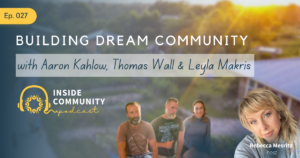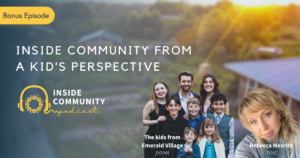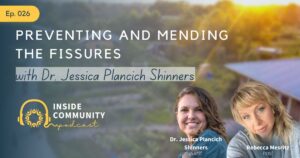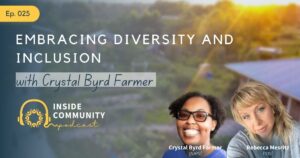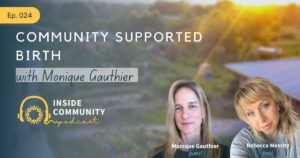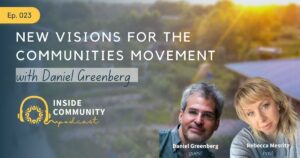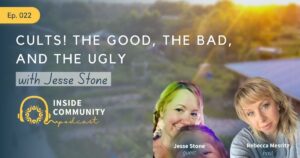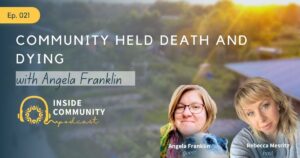Governance & Decision Making with Diana Leafe Christian
Inside Community Podcast — Ep. 007
When it comes to deciding who gets to make decisions and how decisions get made, the communities movement has done a lot to innovate more equitable and transparent strategies. In today’s conversation with Diana Leafe Christian, we talk about the importance of solid governance models and decision making structures, how these structures and a lack thereof can impact everything from relationships to the ability to get things done, and specifically about Sociocracy, her preferred governance model.
- Diana Leafe Christian is the author of Creating a Life Together: Practical Tools to Grow Ecovillages and Intentional Communities, and Finding Community: How to Join an Ecovillage or Intentional Community. An Ecovillage Design Education (EDE) trainer for Gaia Education and editor of Communities magazine for 14 years, Diana has contributed chapters to three Global Ecovillage Network (GEN) and Gaia Education books: Beyond You and Me, Gaian Economics, and Ecovillage: 1001 Ways to Heal the Planet. She is a Board Member of GEN-US. In 2017, she received the Foundation for Intentional Community’s Kozeny Communitarian Award, a lifetime achievement award for contributions to the US communities movement. She speaks at ecovillage and cohousing conferences, offers consultations, and leads workshops in person and online internationally. With the ability to make things simple and clear, and drawing on a deep and broad understanding of community dynamics, Diana encourages effective and harmonious ways for groups to become healthy and thriving, and resolve the typical interpersonal challenges that can arise in any community. You can find out more about these courses, trainings, and services by reaching out to her directly at Diana@abejahummel
Use coupon code INSIDE20 for 20% off your next book order at FIC’s online bookstore at www.ic.org/bookstore.
Follow the show and see inspiring images and video of community life on Instagram @InsideCommunityPodcast – I’d love to hear from you there! If this content has been meaningful or useful to you, please subscribe, rate and review on your favorite podcast platform, and share with your friends and folks you know who are curious about living Inside Community. Your financial support of Inside Community helps us to continue to create meaningful and exciting content and I hope you’ll consider donating.
— Rebecca, your podcast host
Episode Transcript
Rebecca Mesritz 0:01
Thank you for joining me for another episode of the inside community podcast. I am having so much fun talking to people and harvesting their wisdom around what it is to create and sustain community. If you’ve been listening to all these episodes, I know that you are learning a lot right alongside of me. And I hope that you’re getting a lot out of this journey that we’re on together. If these conversations have been helpful to you, I hope you will take a moment to visit ic.org/podcast. You can also just click the link in the show notes and make a donation to the show so we can continue creating this valuable content. Thank you so much for supporting me and supporting the show.
Hello, everyone, welcome back. This is Rebecca Mesritz. In today’s conversation, I’m going to be talking to longtime friend and mentor Diana leaf Christian. If you’ve ever met Diana, then you know that she is just a wealth of information on all things related to community having lived and studied communities for decades. But today, we are going to focus in specifically on governance and decision making and community. Now, this is one of those topics that really sets the community’s movement apart from the rest of the world, and is a place that I think a lot of ingenuity is represented. Diana is a trainer and proponent of sociocracy. And so we talk a lot about that. But we also get down to some of the nuts and bolts of good governance and the process of deciding who decides and community. I do kind of want to apologize in advance because this episode was actually recorded about a year ago, when I was still figuring out some of the technical stuff. And the sound quality just isn’t where I would like it to be. But the information is solid. So hopefully you are not distracted. Okay, let’s get started. I am super excited to have Diana leaf Christian here talking to us today because she has been a friend and a mentor of our community, the Emerald village. In 2008. When we were just starting to meet as a group and talk about doing community, we purchased her book creating a life together, and it became a bible of sorts for our newly founding community. We use exercises from the book as prompts for deep and tough conversations as inspiration for our mission and vision statements and as guidance around legal and structural agreement. Since then, I and my fellow communitarians have attended and hosted her workshops on starting a successful eco village are intentional community. And in 2015, we began training with her and sociocracy the governance model EVO has been using ever since. And in addition to all of that, Diana has a ton of experience in and meeting with communities from all over the planet, and helping them and coaching them and studying them as well as she was a editor of the communities magazine for 14 years. So it is an honor and a privilege to have you with us today. Thank you for being here, Diana.
Diana Leafe Christian 3:17
It’s a pleasure.
Rebecca Mesritz 3:21
Do you have anything else to add to that intro? I know you have a ton of experience I probably didn’t capture there.
Diana Leafe Christian 3:27
Well, the only other thing I add, I would add is that I used to do workshops on starting successful new equivalencies or intentional communities and on sociocracy the governance and decision making method that you use it EBO and now I do those online so I do 10 week online courses in sociocracy. And on starting successful your communities.
Rebecca Mesritz 3:53
Excellent so people can find you and get trained up with you communities can do that as well. I know I’ve I’ve mentioned to you I really want to focus our time together investigating the topic of governance and decision making. But before we get into that, can you give us just a snapshot of your community and and tell us what brought you briefly to living in community yourself.
Diana Leafe Christian 4:19
I can’t remember who I wanted to live in community because I’ve been here so long, and I’ve been interested in the topic for so long. But it was probably 1960s and 70s new agey desire to help make the world a better place and have a better life than mainstream culture. That was probably it. But now it seems to be like I’ve lived in community all my entire life. Which is not true. I’ve only lived here about 21 years. So here is Earth Haven eco village in the mountains of western North Carolina, about an hour from Asheville. It’s in the mountains In the forest, we have a lot of streams, all of our land is either slopey or steep, or ridge tops or flatland by the streams. But it’s not at all flat land, like you think of when you think of an intentional community where you could just build anything anywhere. So we build our houses on the gentle self facing slopes. And we put our agriculture in the flat land and on the gentle north facing slopes where we have no, I mean, we put our houses on the southern slopes and our or orchards on the northern slopes. That’s what I meant to say. And we were a village scale community, we have 10 different neighborhoods, and the people live in, in clustered housing, housing close to each other, and each neighborhood, and all the neighborhoods together creates the whole eco village, we have a village scale economy, which means that we try very much to hire each other for goods and services that we need. So we can keep the money in the borders of our village to the degree that we can. And we work closely with many men, many of our neighbors who are part of the whole village to even there, they’re not on our land, but they’re right nearby, right adjacent. And together, they and we, together create the social village and the economic enterprises that we all help each other with. We are not economically self reliant from mainstream culture. But we are doing pretty well and having most people stay on site to make a living, which is one of the things we want to do. We’re based on permaculture design. And we have affiliated educational organizations that teach permaculture to others, and teach other kinds of sustainability, sustainable activities. So that’s Earth Haven, where I live
Rebecca Mesritz 6:57
in regards to the governance piece. How I guess my first question is really, how do you define governance, because I’ve been on a lot of different forums, and I’m involved in different questions in different platforms. And people have been talking a lot about governance lately. And it seems like everybody has a bit of a different definition. And so I’m kind of wondering what is your definition of governance, and how do you differentiate between that and decision making?
Diana Leafe Christian 7:27
Well, I have a fairly specific way of describing this myself. I think that governance of an intentional community and eco village cohousing, any kind of intentional community is the way they structure how they organize their work tasks and accomplish them, which is generally a series of teams or committees, possibly also a periodic meeting of the whole group. And the decision making method is how they make their decisions. But it’s not the governance. So governance is includes decision making, but is not limited to it. And decision making is a part of governance, but it’s not the whole thing. And so, what are the kinds of things that people are focusing on? Well, they’re focusing on their finances, their their legal obligations and responsibilities, such as paying property taxes, and having liability insurance and doing all the things that they need to do to continue to manage their community project effectively. Many people new to community have no idea that it takes project management, ongoing project management to do it takes clerical and administrative work management work. And so what we are putting our attention to in terms of work tasks, and how we organize them and accomplish them, and look to see if we are doing them well. Or if we dropped the ball. All of that I see is governance. And we do other things. We do physical things on the land. What with tractors and backhoes, or if we’re urban leaf blowers, I suppose. Anyway, we have equipment and we take care of the physical infrastructure of our land. So we generally have one or more teams or committees for that. And we probably have marketing and outreach and promotion and a website and a newsletter and other kinds of things, possibly a membership process for checking out potential new incoming members and orienting them and teaching them what we’d like them to know and having a decision making process as to whether we say yes or no or not at this time, or maybe later or whatever we met say. So there’s an awful lot of things to do, as in, not think about but you know, do actions when you’re an intentional community. So how do you organize all that? That to me is governance, and then how you make decisions about that. That’s the decision making part.
Rebecca Mesritz 10:01
Yeah, just thinking, wondering, really, I’m how we came together at the Emerald village, we didn’t really have a governance, we didn’t have a defined governance model. We had kind of a, we had a lot of organizational experience, it came from more corporate types of backgrounds, but we didn’t really have a strong like, okay, and this is the model that we’re using. We didn’t really have anything like that until we began to implement sociocracy. And I don’t actually really know what other governance models are out there. So can you tell tell me like about what some other governance model options are? I mean, I know a little bit about holacracy. And we had, we use the holographic model, which I think is a little bit different before we started, and I know that there’s sociocracy 3.0. Now, but but I don’t know of any older models.
Diana Leafe Christian 10:58
Oh, well, most communities don’t use holacracy or sociocracy, 3.0, or a holographic model. They might not even have heard of those. Most intentional communities use classic traditional consensus, which they learned from the communities movement, particularly in North America. There are a number of communities consultants, who teach classic traditional consensus as derived from how Quakers do it, perhaps modified a little bit for communities. And that is the model that you will find in almost any other intentional community. Some communities that have used classic traditional consensus and in a moment, I’ll say what that is, I have found it too painful to continue with it. Because of so much conflict and disruption, and demoralisation and heartbreak that can happen. When most of the people who want to pass a proposal cannot pass it, because one or more, but even just only one person doesn’t want to and says no. So many of those communities have shifted to a modified form of consensus. So in my mind, I see classic traditional consensus, which is the majority of communities in the US and Canada use that. And then a smaller group of them have shifted over upon painful experience. They’ve shifted over to a modified form and the modified form that I know will and recommend highly is called the in street consensus method in like the letter in for the N Street, cohousing community in Davis, California, because they developed it. So I should back up a minute and say, for your listeners what classic traditional consensus is, you have a meeting with a facilitator, you have an agenda, people bring proposals or committees bring proposals, and you consider the proposals. When considering a proposal. People discuss the proposal. And the facilitator calls on people in the order that they raised their hand around the circle and create a stack of names of who raised their hand first and second, and third, and the facilitator calls on them. The people give their comments about what they do like don’t like or their concerns or just general comments about the proposal that the group is considering. The proposal is generally visible up on a whiteboard or some kind of electronic device like a big TV screen or a very large computer screen where everyone can see it. And from time to time, the words are modified of the proposal to meet the concerns that are expressed by the people who are speaking, not everyone speaks only the people who raise their hand and get called on speak. Some people raised their hand a lot and speak a lot. And they have a much larger impact on how everything turns out because they are called upon more often. So the proposal slowly gets modified by the discussion. At a certain point, the facilitator and the group realize it’s time to call for a decision and the facilitator. It’s called testing for consensus. So the facilitator says okay, for the proposal that and then the facilitator Risa proposal, as it now is, which is modified at this point, probably, and says we’re this proposal.
And then they asked for three kinds of three kinds of responses. And the first is those who might stand aside from the proposal stand aside like physically standing up and stepping over to the side. This is just a metaphor, though. It means I am not saying yes to this proposal, but I’m also not stopping it. So there may be one or more people who stand aside from the proposal than that facilitator asks Is there anyone who feels the need to stand in the way of this proposal that’s classic Quaker talk, really it means block. Do any people feel the need to block this proposal, if one or more people blocked the proposal that stops it, the proposal does not pass. Now, what most facilitators and whole groups of people and communities don’t know is this is not supposed to kill the proposal dead forever. It just means we didn’t pass it right now. But so many communities don’t realize this, or they’re so discouraged, or they’re so untrained in consensus that they just let the proposal be dead at that point. So you can see why groups would get discouraged and demoralized because just one person in in the room can stop a proposal that almost no one else wants. In some communities, they have this rule that the prison has to say what the reason is, and in some communities, the reason has to make sense to everyone else, and has to be based on the community’s values or, or purpose or mission or basic principles. In other communities, they don’t have that. And the block is the block and then the proposal is dead. This is violating how classic traditional consensus is supposed to take place. But they don’t know that. The other thing that can happen is the person blocking or persons more than one can give a reason. Like, well for the good of the community, which is like a Rorschach inkblot test. That can mean anything, you can project anything onto that, where they can give a reason that nobody dares argue with. Because I mean, I would argue with it, probably, probably Rebecca, you would, too. But the average person just sits there silent, like a deer in the headlights and says nothing. And the proposal is killed by the person or persons who block and nobody does anything and people are discouraged. And the third thing you can do is to approve the proposal. And your silence means you approve it. So if you don’t stand in the way, block, or you don’t stand aside from that means you approve it. So when a proposal passes, because there’s a bunch of silence, and nobody stood aside, or just one or two did the the facilitator says okay, now show your support for the approval, we’ve just, we’ve just passed the proposal proposal and everybody goes, yay, or they do African clapping or something like that. And now the proposal has passed. This is a very, very, very, very conservative system. Because we can hardly ever change anything. We can’t take risks, we can’t try new things. Why? Because once we create a policy or we create a project, we created something rather, that we created because we agreed to it, using classic traditional consensus, it’s extremely hard to ever change it. And you can probably see why Rebecca is because one or more people might say no, and then okay, no, that’s it. No modified forms of consensus. Yeah.
Rebecca Mesritz 18:06
I was just gonna say I just I know that there, there are communities that use consensus, and they use it, they find it works really well for them, and they use it successfully. But we used a version of consensus before we started sociocracy, that we kind of jokingly called consensus or resonance. I mean, the only reason it really worked is because the 10 of us had, I mean, we had such a strong mission and vision and such similar values that it was, generally speaking fairly easy for us to come to consensus, about mostly everything. But boy, when you bring up more touchy, touchy subjects and personal subjects, like I, I talked at length with Dave Henson about dogs and like, difficulty of, of passing things around, and he’s at Occidental arts and Ecology Center. And of course, they use consensus there. And what a traumatic experience that was for I don’t want to say traumatic, I want to put that on them, but difficult trying experience for them to pass proposals around pets, because obviously, people have such strong opinions and beliefs and feelings around their animals. Yeah, it’s all well and good to use consensus on on easy stuff, but you kind of get into the personal stuff. And man, it’s, it can be really, really difficult.
Diana Leafe Christian 19:28
What you just said, it points to the next point I was going to make, and I would say that the communities that you know, that are using consensus well, and loving it and feeling good about it are probably using a modified form. Or and here’s the funny thing, or they are occidental arts and Ecology Center, because that community in this quadrant of the known universe that I know of, that meets all the criteria for using consensus well And the criteria doesn’t fit almost every intentional community. So here’s the criteria to use classic traditional consensus. And these are in the consensus books, that communities tend to ignore this part. And so here’s the criteria, and they meet it, Dave, and the folks at OAC meet this. Their facilitators are extremely well trained. It’s a small group, they have very closely aligned shared values, and vision and mission, like you folks at EVO attend to view when you started it. And they are very well trained at consensus, and they all know how to do it. And it’s the same form that they all know. And there, they don’t have two or three people with two or three different ideas of how you do it. In their mind, they’re all on the same page. And they are willing, willing, willing, and also willing to devote hours and hours and hours and hours processing time when in if we ever deal with pet policy, or dogs or even cats, or your turtle and my ant farm and his boa constrictor. Whenever we deal with animals, or children. That’s where we find out how well our decision making process works. So the modified form of consensus that I was about to tell you about when you get to the decision point where we’re going to call for consensus, call for consensus, all right. But if you have anybody blocking, you have a recourse to bypass their block, and have that person join in a small group of people who recraft the proposal and bring it back so that you must be part of the solution if you’re going to stop it. And that was that was generated by the folks at in st cohousing in Davis, California. So the thing is, any proposal that you would have in an intentional community, or really any group is to solve a problem. Or it’s to benefit from an opportunity, or both. So when you have a decision making method that stops everything in its tracks and kills the proposal dead Rest in peace, then you haven’t solved the problem, it still remains or you lose the opportunity to benefit from the opportunity, right. And this is demoralizing to folks. So there needs to be a way to move forward and to help the people who are cautious or hesitant, or don’t want to pass a proposal to be part of the solution. Yeah,
Rebecca Mesritz 22:23
I think you know, the interesting thing that you touched on in in that also, which is something that I know that you talk a lot about in your three aspects of the healthy, thriving eco village, and is this sort of the secret aspect, the secret hidden aspect that’s plugged in there, which is training, and just the importance of regardless what decision making model or what your practice is around your governance. Just the importance of continually getting more education, getting more training, always making sure that as a group that you are coming back to the to the teaching and learning and honing of the skills of communication and process so that you can Yeah, not get bogged down with these things. And also stay fresh in in your understanding of it. Because it’s really easy to have the decision making model shift or the governance shift back into old ways of doing things that probably didn’t serve you before you implemented your new way of doing things. So I we started talking about we started talking about consensus, but my initial question for you is actually about governance was about not different decision making models, but different governance strategies, different governance models. So I’m curious as I’m curious about that.
Diana Leafe Christian 23:50
Oh, sure. Forgive me if I answered about decision making when you asked about governance, because maybe I did. The governance models that I know generally are either sociocracy, which is much newer. In the field of eco villages and intentional communities and cohousing communities these days, more and more communities are using it. And I certainly encourage them to and I teach this online and only to people in communities, that’s who my people are, who take my trainings. But usually it’s a combination of either classic consensus or a modified form along with kind of a generalized group of committees or teams to do different kinds of things. And then whole group meetings. So you might have a community that has whole group meetings, which they might call business meetings or some community consultants call them plenary meetings meeting you know, of all of us and and then these People are making bigger decisions that we need all of us to make the decision for in the whole group meeting, but then there’s a committee dealing with finance issues, and they do the bookkeeping and the invoicing and the collecting of money. And they make decisions with in the realm of their authority, which the whole community grants them in the finance committee. And then there’s the membership committee, who does those membership tasks and, and then there’s the promotions Committee, which promotes the community through the website and brochures and newsletters and going to events, and so on. And then there might be a repair and maintenance, physical infrastructure committee or team or one or more of them, because they can have more than one, because earth Haven is a village scale community. It has about 11 committees. Some of them are great, big, significant, big issue committees. And then those committees have what you call sub committees that do the smaller thing. So we have a promotions committee. And then there is a smaller website committee, but it’s attached to the promotions committee. And then there’s the meeting of everybody. And the decision making method used here has drawn partly from the in street consensus method, and partly from sociocracy. And partly from this, that and the other thing, and it’s now working pretty well as compared to the days when we use classic traditional consensus. And you know, Rebecca, there’s something you said a while ago, which I think is very significant. And you’ve probably experienced it EVO, which is that in a decision making method will work just great when you all agree. But the rubber hits the road when we don’t agree. And we’re generally shocked, stunned and shocked when we find out how vociferous Lee and filled with emotional pain, we all may be on various issues, like a pet policy, and then we’re not agreeing. And our decision making method is just met up to it. And we have conflict. And that’s what we find out oh god, maybe we need a better map.
Rebecca Mesritz 27:23
The inside community podcast is sponsored by the Foundation for intentional community. The fic offers a range of support for folks interested in learning more about and connecting with communities, including their recently launched intentional community forum. The forum is a place where you can go from dreaming about community to doing it. Here you can meet and chat with people who are looking for community or who are looking for members share tips and tricks on everything from permaculture to conflict resolution, or just get the latest news on what’s happening in the communities movement. Join the conversation now online at forum that I see.org. You know, the other thing that you kind of touched on when you were describing consensus around how there are certain voices that may raise their hand multiple times and have multiple things to share and other people that sort of sit there quietly. And maybe not don’t say anything. And this is sort of one of the downsides, I think that I that I noticed when we were using consensus was that it was very easy for people like myself, for example, who has no problem and everybody know how I feel about something to kind of like come in and dominate a conversation or dominate a decision. And then people that feel less comfortable sharing with their thinking or feeling or people who you know, just need a little more support drawn, being drawn out to share their opinions and their thoughts about things and have really good information and really good insights into things end up potentially feeling resentful that one person or a few people in a group seemed to be dominating and holding a lot of the power or a lot of the control. And, you know, I’m sure it’s all innocent enough, really. But it does create problems down the line. And so it was one of the real things that I was super grateful for when we did begin to implement sociocracy because the socio kradic process and all of the circles really allows for every every voice in the circle to be heard. Yes and and you can opt to not speak in a moment but everyone you go around and everyone gets a chance to share their wisdom share their insight, which Yeah, in some ways makes the process go a lot faster. Even though more people are talking thing. In the end, you have less resistance to the final to the final proposal because you’ve actually taken into account all of the different the different aspects and the different opinions and different thoughts about it as you’re creating it.
Diana Leafe Christian 30:14
Yes, you know, we should probably tell your listeners what you mean. And I mean by that, which is that in consensus both kinds modified and traditional, the facilitator calls only on those people who raise their hands, Mr. or Miss assertive, Mr or miss confident Mr or miss verbose and loquacious. Whereas in sociocracy, the facilitator calls on each person around the circle, even if they don’t, nobody raises their hand, they just get called on one after the other as they’re sitting there in the circle, and the facilitator includes himself or herself. And this way each person is invited to speak, they can say, pass or nothing to add, and then they can, and or they can speak to the issue. And this is so fair, and so kind, and this is one of the reasons people love sociocracy.
Rebecca Mesritz 31:06
Yeah, and and it’s not without its faults, I mean, definitely, when we get into these, you know, the dog issue is such a good one. And I think for people who are not yet living in community, though, they might sort of scratch their head and just be like, really pet like, that’s the big thing. That’s, that’s what stuffing greatness in community is dogs. But, ya know, it really is, and even after we implemented sociocracy, in our community, we using the socio kradic process, did some work around a pet proposal. And, yeah, there was a, there was a time if Believe it or not, that I did not agree with the proposal, but because we had been talking about it, and it was just like, ah, gosh, we got, like, Can we move on from this thing? Already, we’ve been working this thing for a long time, not just in that meeting. But over the course of weeks, different aspects of talking about this particular proposal related to a dog. And I didn’t agree with it, I didn’t want to do it. I didn’t, it didn’t feel right to me. But in the end, I stayed silent and just was like, Okay, fine, we’ll just pass it
Diana Leafe Christian 32:23
was using consensus, or when you were using, we were using
Rebecca Mesritz 32:27
sociocracy, we were using sociocracy. But we still we there was still, I mean, you know, you get into some of these things in some of these proposals, and they’re not cut and dry. It’s not like, I mean, when you have two different opinions about a thing, and it’s something as personal as a pet or pet ownership. We were having a hard time squaring it. And so in the end, I was just like, alright, well, maybe this is just my opinion, and I’m just gonna, I’ll just let it go. And then, you know, six months, a year later, the things that I was holding as, this is not a good idea. And these are the reasons why this isn’t a good idea. And this is what we need to figure out about this, before we consent to this proposal ended up happening. And it was a mess, it was, you know, it created even more conflict, because some of the things were related to, you know, like, who was going to pay for damage, who was going to pay for damage that was done and who actually owned the pet. And it was, I mean, it got really convoluted and sticky. And just the only reason I sort of bring this up is because even even when we do not have our best intentions of having a solid decision making model, there’s still a fallible humans inside of that, who maybe don’t live up to what the what we would hope in that moment of making those decisions, and then have to deal with the ramifications of that down the line. And so I don’t know, it’s just all an interesting piece of that process.
Diana Leafe Christian 34:03
Yes. Well, you know, hearing what you say, Rebecca makes me really wonder about whether it might have gone differently. If the people in the circle that were talking about this, and I’m thinking it was your whole group circle at that point, had used the sociocracy proposal forming process. First, identifying all the aspects of the issue of dogs, which would have included when nobody owns a dog who owns a dog when the whole community owns a dog who’s actually responsible for the dog, we need to decide that. And another one would be who pays for damage when a dog owned by nobody does damage and who pays for damage when the dog owned by somebody does damage and who pays for damage when a visiting dog that comes in from elsewhere does damage and you would have thought of everything that you could think of around the circle over and over and over? I mean around and around and around brainstorming and rounds And when you’d had all those things listed, you could start then brainstorming little proposal pieces, one or more for each of those aspects. So you could have created a more thorough proposal, in which case, the things that you could see, because you could see ahead of the future, what could go wrong, they could have been considered at the get go. But I’m guessing that when you try to do that, because you knew sociocracy better than everyone else in your community to start with, that you didn’t get too far, people probably just said, Oh, for God’s sakes, let’s just talk about this and then write a proposal.
Rebecca Mesritz 35:42
I mean, that’s definitely a version of what it’s probably a version of what happened. I mean, it was it was a very heated, they were very heated conversations. And I think that’s kind of what this the, the need for a very clear and defined decision making model speaks to is that, you know, you might be doing a proposal forming in this case, I’m going to speak personally here, because, you know, this is really about the beautiful and messy realities of living in intentional community. That’s what I’m trying to cover here. And it’s kind of vulnerable, and a little bit scary. But that being said, even though we were talking about a new dog coming into the community, there was this backlog of other personal process, basically, that went, that had nothing to do with the dogs. It had to do with goats. It had to do with Rebecca, and the husbandry program and having goats. And, you know, it was there were things that weren’t really on the surface that were actually related to it that were kind of brought up and, you know, things things get can get really messy really quickly, especially, you know, when it when it is shared responsibility and, and personal things like this. And so, you know, that’s why I love what you’re talking about right now, Diana, which is having going through and being really diligent in these meeting processes, even though they might seem onerous, actually helps in the long run, because it takes us out of the personal and brings it into the slightly easier to kind of everybody can an agreed upon reality, you know what I mean? Not my personal process, but the agreed upon shared reality.
Diana Leafe Christian 37:40
Once upon a time I was facilitating at your community to demonstrate proposal forming. And your community had a seven year old issue that for seven years, some of you thought we better deal with this, but various people didn’t want to and you didn’t, so that by the time we did proposal forming, we were going around and around and around this circle of alternative view, gathering aspects of the issue. And it turns out that it was three or four or five issues. It was what was your policy about this? It was? How do you live out your values about these health issues, it was about have we or have we not communicated things we wanted to communicate to a certain person, or we felt too constrained to actually communicate them, or we did communicate that the person said, and so what or something and it didn’t really go in, and all these different issues, which involved a person, your whole policy about people who had come and live there for a while and various other things. And it turned out to be quite a few different issues. And it took hours to do proposal forming and some of the people in the room who weren’t very used to sociocracy yet, of the whiskered variety, those fellows said, this has taken so long, why is this taking so long? Why do we have to do all this? And I don’t think I had the iceberg analogy at that time. But now it will make the iceberg analogy. Here’s the water surface. Here’s a little tiny piece of the of the iceberg poking up above the surface of the water. And here’s this huge 90% of the iceberg under the water. With little tiny point poking up above the 90% is the heavy lifting that you do in creating the proposal. When you think of all the aspects, like in my ideal imagination your group would have done with a dog proposal. And then all of the things that you saw that weren’t handled that needed to be handled in the future. And that strangely enough, all happened a year later, even though you kind of couldn’t warn people that they would probably happen if we don’t deal with this. Well, they would be brought up then in the proposal forming process and then I see that consent decision making process that follows is like the little tiny point of the top of the iceberg. King above the surface of the water, meaning that we don’t have to do very much when we come to consent to this proposal, because we did all the work when we created it. And the very bewhiskered humans in that room, the guys who didn’t like the idea, really liked it when they saw how complete that proposal was, which turned out to be several proposals. The next week, the group of folks who drafted the proposal brought the proposal back and it was crystal clear, it was actually several in there are really clear, and they consented to the really quickly. Because all the work had been done. And the 90% of the iceberg under the water, all the work had been done. And then hours that we spent doing a proposal forming process. So the thing about having conflict like this in groups, has to do with whether or not you actually use all the parts of the decision making method and use them accurately. If so, it tends to help a whole lot, if not, oops, classic, beautiful, complex and messy community dilemmas, like you said earlier.
Rebecca Mesritz 41:10
Yeah, yeah. And, you know, the, the other, you know, beautiful thing about it is that when the proposals come through, and they’re very complete, and they have all of the things that, that you would want a proposal to have, like dates, and numbers, and the who, what, where when’s And why’s and when you’re going to take a look at it and see if it was done well, and all of those things, it’s more than just a proposal at that point. It’s actually a plan. It’s actually, it’s actually, it’s actually it’s not just like, hey, why don’t we do this thing, that’s a proposal. This is it, this is an actual plan that’s agreed on, that then becomes the roadmap for success, as opposed to just them kind of like, oh, a place where a lot of assumptions and, you know, misconceptions can occur. Because you’ve agreed on all of all of the next step, then there’s follow through on that, which is quite liberating, and really helps I think communities, it’s helped our community to be super effective and getting things done.
Diana Leafe Christian 42:22
I agree completely. When you do it well, and you do it right, this proposal forming process, using all the parts and doing it the way it was designed. You don’t just have a proposal, like, hey, let’s do X, you have a plan. It’s kind of like an administrative plan. And it supersedes any amount of ongoing discussion, because it’s so clear and so helpful. In fact, I would venture to say that it’s kind of worthless when you have a sticky wicket issue, like what are we going to do for a dog policy in our community, to have discussions with people around the room saying things, it makes a whole lot more sense to place all that through the filter of the proposal forming process in sociocracy, which brings out all the same points, but in such a clear way that you could just see them and keep them, you see them and keep them in front of you visibly, and then you can address them. I have a new way of teaching proposal forming in sociocracy. It used to be the thing that was the most complex part of it. Now, it is the easiest and simplest because I teach it in my free online, socio sociocracy overview sample classes. And it’s a visual thing with a template that you see on the screen with aspects of the issue on one side in a column and specific proposal ideas on the other that are all on the same space as on the other side of the little chart, that aspect of the issue, you could probably visualize that. And it makes it very visual in front of everyone’s eyes when people learn proposal forming like that, and they love it and they take it up to their community and use it. So I just am thinking a whole lot about this lately about how beautifully created proposals that are clear and thorough like this can prevent a lot of conflict later. Like you said.
Rebecca Mesritz 44:19
Yeah. Yeah, I mean, it’s, it’s interesting because for me, that proposal forming, I mean, there’s so many aspects of sociocracy. And I want to ask you more specifically about sociocracy in a moment, but, you know, part of what comes up for me and all of this is in all of the kind of formalization of these processes. I see it becomes it can feel kind of overly bureaucratic. It can feel almost like a like I don’t know if In some ways, I appreciate the the completeness of the proposal. But I also see other people and even myself sometimes struggling when when you just want to make a decision, or you just want to kind of push something through and it feels very like bureaucratic. And there’s all these steps and everybody has to know everything, and why can’t we just? Why can’t we just make the decision? Like, can’t we just talk it out and make the decision? And so I’ve seen there be times when, you know, here at EVO, we’ve gone, not gone back, but we’ll some decisions will happen sort of on the fly and easily. But then when it comes time to make a decision that we want to use a proposal forming process for? There’s a lot of like, Ah, it’s gonna take a long time. And do we have to kind of an energy and I just wonder if you have any advice or tips for for communities that might be in a similar position?
Diana Leafe Christian 45:58
You mean if they use sociocracy? Yeah, if they use sociocracy? Yeah, well, to use the template form, which they email me at Diana, leaf, Christian webinars@gmail.com. The leaf my middle name, l e. A, F, E has an E on it, Diana leaf, Christian webinars@gmail.com and say, Hey, you have proposal forming information? It sociocracy I’ll send it to them?
Rebecca Mesritz 46:30
Well, I mean, we’ve learned a lot. We’ve learned a lot from this process. You know, we started I think, yeah, we started in, in 2015, I did the training with you. And we began to implement it and integrate it right away aspects of it. And then over the next it took three years to get everybody trained here. I know, it takes a long time when you’re talking about multiple people with busy lives taking a weekend or time out of their schedule to really drop in. But it’s so important and everybody get, you know, whatever your governance model is, or whatever your decision making model is. And again, I just come back to this is what I really like about sociocracy is that it is both a governance model and a decision making model. So you have it’s like the whole package. It’s kind of plug in plug and play in that way. And it’s it really values. The transparency, that I think a lot of people that are interested in intentional community want it values efficiency and values equivalence, and, and giving people who are trying to escape our hierarchical, you know, white supremacist culture, top down culture, even though it may seem like a stumbling block to learn it, once you learn it, and can integrate it and implement it, then you have this amazing skill that allows everybody to have a voice and all the voices to be heard and decisions to be made by everyone. Which is I mean, that’s, that’s what I think a lot of us come to community for, to begin with.
Diana Leafe Christian 48:11
Yes, the values of, of transparency, effectiveness and equivalence voice, I think are probably pretty common in people who are drawn to community just like you say, you know, when you say there’s things about it that you and Jessica don’t like, and you’re looking to sociocracy 3.0, I would suggest looking at sociocracy the way it’s actually designed in in its clearest way of being described that, that I’m now doing knock on wood be as compared to before and see what you think. Because my guess is if you use it exactly as it’s designed with all parts, which mutually reinforce the other parts, that you think, Oh, we’ve already got a really good thing here, we just have to make these few adjustments. I’m guessing that’ll happen. So we’ll see. And secondly, you know how you said it took three years to learn it, it actually takes about 10 weeks to learn it. But if you are in a group, where some people haven’t learned it, and they’re used to what you’ve done before, which is 99% of the time you just chat with each other and then I’ll decide and it’s fine. That feels so good that you don’t want to go and learn a whole system. So when this kicks in is being really valuable is during the dub policy. Time Are you know, when you have when you have a great need for clarifying and getting clear on all aspects of something controversial and with a lot of emotional charge on different parts of it like a pet policy, like a dog policy. And so it’s no wonder that communities that have been doing pretty well and some of their people go and learn sociocracy and come back enthusiastic about it. And others go Why do we have to learn this whole new thing things are fine, that it would take a long time for the Luzia tastic ones of which you were one of them, to convince the others to actually even invest the time in learning it. So,
Rebecca Mesritz 50:09
oh, yeah, it’s true. And there were I mean, the good thing is that there were other people who learn Kennedy was living here. And she came into the LA ecovillage course with me. And so we had multiple people that came and got trained in it, and brought it back. And then other people got trained in it. And so there was there was a tide, there was a tide who was seeing, we need a better way. And, you know, even though we’ve talked a lot about the dog policy, being a real tricky thing, there’s been so many other decisions and proposals and things that we’ve planned for over the last eight years, that seven, you know, seven years, maybe five years, since we’ve really been using it well, that I’ve gone so smoothly, because we have agreed on, on things and just in terms of how the community functions, the governance model and having the different circles and some of these other aspects that we, you know, people when they take your course can learn more about it just helps everybody to interact with the organization a little bit more clearly and easily. Yes, you know, the other piece of it that I really do appreciate is just the idea that we are, we’re always experimenting, and then evaluating, and then creating the new plan. And so there’s constantly going to be this evolution. And that’s part of my hope for all communities, as well as that they’re continually evolving, and then continuing to make this thing better, whatever it is that they’re doing is their own little community, but also sociocracy and their governance model and learning more about it and getting better at it and saying, hey, does this work? How could how could we improve it? Alright, let’s try that. That worked better? No. Okay, let’s go back to the other way of doing it or whatever. Yeah, whatever that thing is, you know, and I just, I love that experimental evolutionary aspect of this conversation.
Diana Leafe Christian 52:18
Me too. sociocracy is designed that you’re going for continuous improvement of your organization of the functioning of each circle, which means committee or team and of your own, how you do a role that you might have in the whole group or in a circle. So I love that part of it. And, you know, teaching sociocracy has caused me to inhale it into my psyche. So when I get negative feedback about myself, it does hurt. But rather than me doing some self recrimination, self blaming, little fit, what I do instead, besides that it does hurt is that I think, Oh, now I know, that doesn’t work. And then I try something different. Because I realize I’ve just gotten valuable feedback. Sometimes it’s valuable feedback to know what doesn’t work. And you’re glad to get it even though Oh, but you know, then you can go do things better. So I love that about it. And communities get to experience that when they use it when they use it. Rebecca, I haven’t even told you about the four necessary conditions. So I now have four necessary conditions that I preach on my soapbox that a community needs to have for sociocracy to work well. What is it, everybody learns it? What is the E use all seven parts, not just some of the parts. One is that you use them as they were designed as your sociocracy train your teachers, you rather than mixing them with some other thing. And the last one is just what you said, you get more training, you get review trainings, you get review consultations, or you just do an email consultation or a zoom consultation, to solve a problem that you have by asking your teacher or a teacher, a sociocracy. Teacher, what do we do now? And when those four conditions are met, which some communities do and others don’t, and the ones that do generally are thriving with it, and the ones that don’t are generally having difficulties, but you get the four benefits, which is we have better meetings, we get more done, we’re more organized and we feel more connected to the other group members, and those are the beneficial benefits that occur when a community ecovillage cohousing or whatever meets what I call the four necessary conditions.
Rebecca Mesritz 54:43
I do have one other question for you. That is Yeah, kind of more touching into something that we’re facing as we’re getting ready to start our our new project and So I guess there’s two parts of it. I’ll just start with start with the first one, which is, what have you seen that has been successful around? tiers of membership and decision making power? And kind of I guess it’s these kind of connected sort of this idea of when or when is it? Okay, for there to be a hierarchy in who gets to make the decisions?
Diana Leafe Christian 55:24
Oh, it’s always okay. As long as super clear. So yes, I have seen hierarchies is one way to call it. But since that word has a lot of emotional charge on it for a lot of folks. And it’s not really what I mean, I would say different levels of membership, where the responsibilities and the rights of that level sort of match the level. So let’s say that there was a community with people who owned the land and the buildings, and they owned all everything. And they had some renters, and the renters rented the buildings. And together, they all made decisions about community type, activities, projects, and so on. And only the owners made decisions about things that affected property value, and affected the long term planning and long term activities of the community. Because the owners have a commitment to the long term and that renters do or don’t, depending on how things turn out in their life, renters are much more likely to leave a community property than the owners because they can leave more easily financially, they just come to the end of their lease, or they break their lease, pay the, you know, they lose their last month’s rent, and then they leave. Honors don’t leave as easily. So I have two handouts that I love to share with people and I will send them to you. And I’m making a note to do this, that are oh, how to create a very, very, very, very clear agreement between renters and owners. There are other levels of membership we can talk about, I’m just going to talk about this one for this moment. One of the handouts is a template for how you can create this agreement. And the other is an actual agreement of an actual community that use the template and fill them in and shows how they did it. So what it is, is it four parts to this. One part is what the renters have is their responsibilities, and what responsibilities they do not have, and what rights they have, and what rights they do not have, and the owners what responsibilities they have, and responsibilities they do not have, and what rights the owners have, and what rights they do not have. So this all fits together, generally the rights that the owner has, or some rights that the renter does not have, and so on. So the renter, and the owners sign this agreement, which is like a contract, to make it even more powerful, you can get it notarized, and then the renter has a copy of it, and the community has a copy of it. And you can always look up the copy and a physical copy along with anything online. And the whole idea is the renter is agreeing that he or she or they know that these are the rights I have as a renter in it, but I don’t have these rights. These are the rights that I have, I mean the responsibilities that they have, but not these. And your owners, you have those rights and responsibilities. And I know this going in. And since I know it going in, I can’t complain that you never told me this, because I signed my name right here, John Hancock or Jeanette Hancock. And the point is, if it’s super clear to start with,
you can do that easily. And well. And you all do you have renters there and it seems to be working out well. Another level of membership might be called associate membership. So here at Earth Haven, we have owners of actual property. And we together have one decision making body. And then there are people who are not members yet, or who are neighbors, or who are long term residents and they don’t plan to become members but they plan to live here forever. And they joined this other organization called the earth Haven Community Association. It’s a non exempt nonprofit. It’s an actual legal entity. And dues are collected and there’s a bookkeeper and things are purchased and we run the community activities through this non exempt nonprofit called the earth Haven communities. Association. But everything connected to land is run through the earth Haven Homeowners Association, the people who actually own the land of which I am one of them, were members of the homeowners association as well as the Earth Haven Community Association, homeowners association dues, and money collected and money spent is for all the things that have to do with land, repair, maintenance, purchasing land, developing land, managing land, all of the activities of an actual intentional community, oh, your membership, your website, all those things, community tours, they are the wrong kind of money to go into the bookkeeping of a homeowner’s association anyway, legally, and according to the IRS, so we keep it all over in this other legal entity. So I and all other people here are members of two legal entities and we pay two sets of dues one, two each. And it works out great.
Rebecca Mesritz 1:00:59
Oh, good. I love that. I love that. It’s so clear.
Diana Leafe Christian 1:01:05
People who live nearby, like their neighbors, and they’re totally part of the family. They’re on committees, they do work. They come to all the social events. They’re involved in the economic whole thing that we’re co creating together. They’re members of the earth Haven Association, and they don’t own one molecule of land here, but they don’t need to.
Rebecca Mesritz 1:01:24
Diana, leave Christian, thank you so much for taking the time to talk to me. I’m so excited to have been able to hear your thoughts on governance and decision making. It’s been such a pleasure.
Diana Leafe Christian 1:01:36
Thank you. It’s been a pleasure for me as well.
Rebecca Mesritz 1:01:42
Thank you so much for joining me for another episode of the inside community podcast. Diana leave Christian offers courses and support for folks at all stages of creating community. She has an upcoming six week online sociocracy class starting on April 30, and will also be offering an introduction to sociocracy for CO housers class on August 25, ahead of the national cohousing conference in Madison, Wisconsin. There she’s also going to be speaking on her recent communities magazine series, working effectively with especially challenging behaviors. You can find out more about these courses and her other work by reaching out to her directly at diana@icy.org. And as always, if you’ve enjoyed this episode, if you’ve enjoyed this show, please write a review. Subscribe to the show. Like us, hit all the stars, do all the things and then maybe bounce on over to Instagram and follow me there at inside community podcast. On my inside community podcast Instagram page, I’ve got videos, I’ve got reels and photos and updates. So it’s a great way to reach out to me and just get a visual representation of what it’s like to live inside community. Thank you so much and I look forward to seeing you next time.

Listen & Subscribe
Recent Episodes
- 027: Building Dream Community (even if you don’t live in community)
- Bonus Episode: Inside Community from a Kid’s Perspective
- 026: Preventing and Mending the Fissures with Dr. Jessica Plancich Shinners
- 025: Embracing Diversity and Inclusion with Crystal Byrd Farmer
- Bonus: Centering and Preparing for Birth with Monique Gauthier
- 024: Community Supported Birth with Monique Gauthier
- New Visions for the Communities Movement with Daniel Greenberg
- Cults! The Good, the Bad, and the Ugly with Jesse Stone
- Community Held Death and Dying with Angela Franklin

About the Show
The Inside Community Podcast brings folks along for an inside look at all of the beautiful and messy realities of creating and sustaining a community. We provide useful and inspiring content to support people on their quest for resilience, sustainability, and connection.

Meet Your Host
Inside Community Podcast host Rebecca Mesritz is a community builder living in Williams, Oregon. In 2011, Rebecca co-founded the Emerald Village (EVO) in North County San Diego, California. During her ten years with EVO, she supported and led numerous programs and initiatives including implementation and training of the community in Sociocracy, establishment of the Animal Husbandry program, leadership of the Land Circle, hosting numerous internal and external community events, and participation in the Human Relations Circle which holds the relational, spiritual and emotional container for their work.
In June of 2021, with the blessing of EVO, Rebecca and 3 other co-founders relocated to begin a new, mission- driven community and learning center housed on 160 acres of forest and farmland. Rebecca is passionate about communal living and sees intentional community as a tool for both personal and cultural transformation. In addition to her work in this field, she also holds a Master of Fine Arts degree from San Diego State University and creates functional, public, and interactive art in metal, wood, and pretty much any other material she can get her hands on. She is a mother, a wife, an educator, a nurturer of gardens, an epicurean lover of sustainable wholesome food, and a cultivator of compassion and beauty.

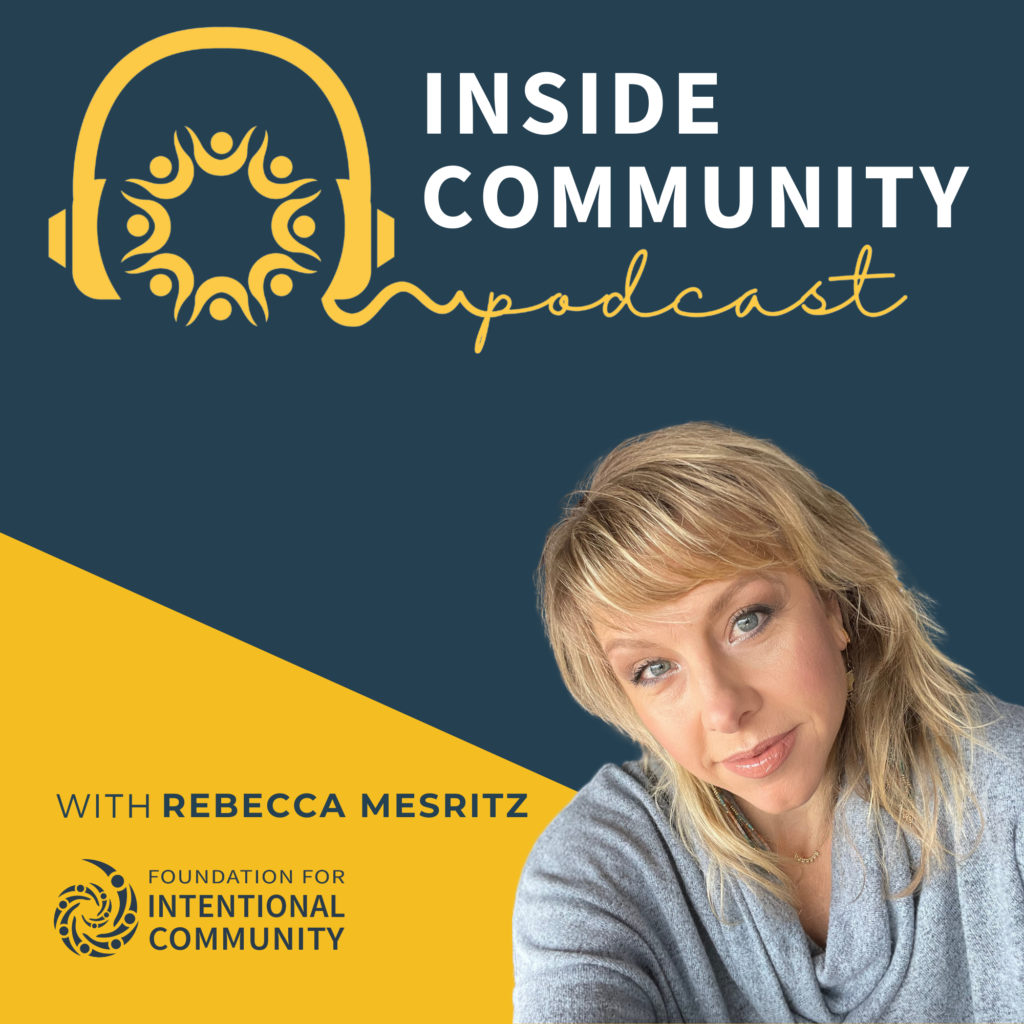
The Inside Community Podcast is sponsored by the Foundation for Intentional Community (FIC). Reach out if you are interested in sponsorship or advertisement opportunities on the podcast.

